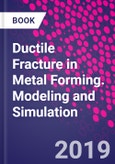Ductile Fracture in Metal Forming: Modeling and Simulation examines the current understanding of the mechanics and physics of ductile fracture in metal forming processes while also providing an approach to micromechanical ductile fracture prediction that can be applied to all metal forming processes. Starting with an overview of different ductile fracture scenarios, the book then goes on to explain modeling techniques that predict a range of mechanical phenomena that can lead to ductile fracture. The challenges in creating micromechanical models are addressed alongside methods of applying these models to several common metal forming processes.
This book is suitable for researchers working in mechanics of materials, metal forming, mechanical metallurgy, and plasticity. Engineers in R&D industries involved in metal forming such as manufacturing, aerospace, and automation will also find the book very useful.
Please Note: This is an On Demand product, delivery may take up to 11 working days after payment has been received.
Table of Contents
1. Macroscopic ductile fracture phenomena 2. Macroscopic ductile fracture criteria 3. Microscopic ductile fracture phenomena 4. Microscopic ductile fracture criteria 5. Micromechanical modeling using an ellipsoidal void model (author's model) 6. Simulation results using an ellipsoidal void model aAuthor's model)








